
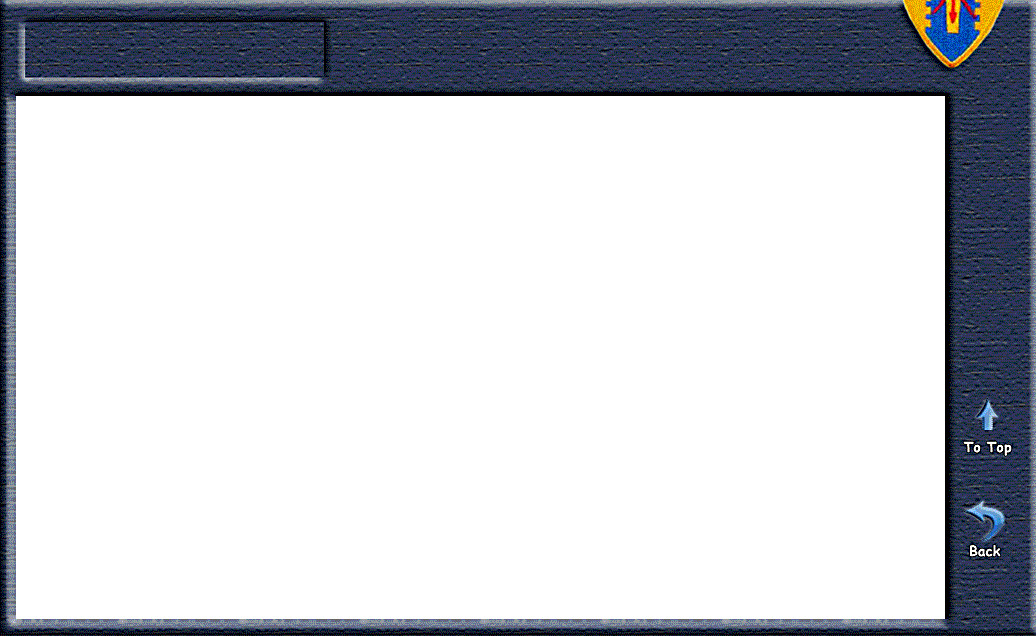
Chup Rubber Plantation Cambodia - 1971
by Ken Mick
This story is a composite of several incidents which happened early in my time with F/4 Cav in October or November 1971 while based at Lai Khe. All of the events are memories of personal experiences, but did not all occur on one mission. As I recall, my first combat AC (Aircraft Commander) was CPT Lee Cranney; thus AC CPT Lee is based on him, with attributes of CW2 Jeff Griffin and CW2 Pat Broderick. All three ACs acted as teachers and mentors during my combat training. The loach pilot may have been CW2 Sparrow.
.....................................................................................................................................................................................
Preflight required that I get to the Lai Khe flight line and examine the assigned aircraft before the Aircraft Commander (AC) arrived. I climbed over and around the AH-1G Cobra helicopter gunship in preparation for my first combat mission.
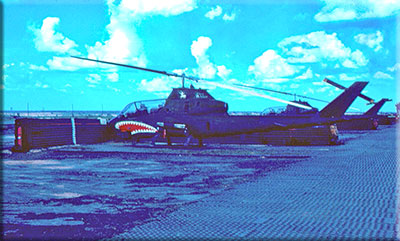 I maneuvered around the gunship inside the walls of the L-shaped revetment, checking fuel, armament and condition of rotors and fuselage surface. This “Snake” carried thirty-eight 17-pound rockets in two inboard pods and fourteen flechette rockets filled with 2200 tiny “nails” in the two outboard pods. Firing the rockets and flying the bird gave the Aircraft Commander plenty to do from his back-seat perch.
I maneuvered around the gunship inside the walls of the L-shaped revetment, checking fuel, armament and condition of rotors and fuselage surface. This “Snake” carried thirty-eight 17-pound rockets in two inboard pods and fourteen flechette rockets filled with 2200 tiny “nails” in the two outboard pods. Firing the rockets and flying the bird gave the Aircraft Commander plenty to do from his back-seat perch.
I examined the front turret mini gun and 40mm grenade launcher with special care, as they comprised most of the quick-response defense for the OH-6 Loach scout ship that we would be covering. I took time to inspect the drum of 40mm ammunition and 7.62 cal ammo for the minigun. 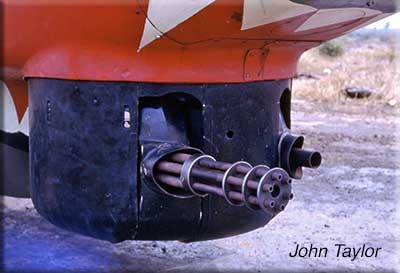
These weapons and their firepower were my special responsibility as Co-Pilot/Gunner in the exposed front seat of the Cobra. I checked the cable which ran from the ammo drums to the guns for security as cables often broke, causing the guns to jam, leaving the front-seater in an unarmed state.
Finally I eyeballed the co-pilot’s compartment, with its flex mount for the turret, the stubby side-mounted cyclic stick, collective and the anti-torque pedals. I tuned radios, then re-checked the log book. The crew chief (CE), having attached the battery, stood by to act as fire guard 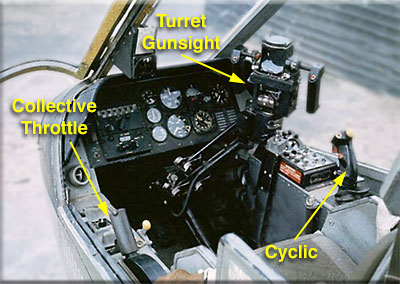 during starting the engine and then he would guide us out of the revetment.
during starting the engine and then he would guide us out of the revetment.
Captain Lee, the AC, arrived, did a quick walk around, glanced at the log book, then peered at me skeptically. It was often tense the first time you flew with a new guy!
“Ready?” he asked while checking my map for indications of our assigned VR box which showed the search area. “Yes, Sir.” It was my job as co-pilot to keep the Loach in the box, monitor the three primary radios and keep track of any friendly forces in the area.
CPT Lee and I climbed into our respective compartments, ran through the starting sequence, shouted “Clear” and pulled the starter trigger. The crew chief, having untied the rotor blades and removed all safeties, stood by.
The turbine whined, the igniters popped like super spark plugs and the Lycoming Jet engine roared.
With canopies closed and latched, the CE guided the hovering aircraft out of the revetment and onto the ramp. AC checked that the Loach and our attendant Huey were present, then called: “Tower, Centaur 49 flight of three, hover taxi for Runway 09 departure.” With Loach leading, tower cleared the flight to depart.
Our Hunter-Killer Team of an OH-6 Loach scout, AH-1 Cobra gunship and UH-1 Huey acting as C&C and quick reaction (in the event of a shoot down), taxi out for take off and head west.
“Centaur 49 flight, contact Binh Duong artillery.” I quickly changed the frequency and noted the artillery advisories. We climbed to above 1500 feet, putting us out of effective small-arms range. When clear of the immediate Lai Khe area, we went weapons hot.
 The mission required that we fly from Lai Khe for about 50 KM (Klicks), northwest to Tay Ninh, the provincial capital. There we would join other aircraft at the airstrip and refuel at the Tay Ninh West forward area refuel rearm point. After fueling at the FARRP, we would head north past Thien Ngon, a star-shaped ARVN base camp near the Cambodian border.
The mission required that we fly from Lai Khe for about 50 KM (Klicks), northwest to Tay Ninh, the provincial capital. There we would join other aircraft at the airstrip and refuel at the Tay Ninh West forward area refuel rearm point. After fueling at the FARRP, we would head north past Thien Ngon, a star-shaped ARVN base camp near the Cambodian border.
For my first flight into this Area of Operations (AR), CPT Lee acted as tour guide, pointing out salient points of interest. He noted Dau Tieng, home to a large Michelin rubber plantation and ahead, Nui Ba Den, the Black Virgin Mountain, a 3200 foot dormant volcano rising spectacularly out of the checkered flat terrain like some giant breast! “A great landmark with a friendly base at the top and bad guys below. Don’t fly too close.”
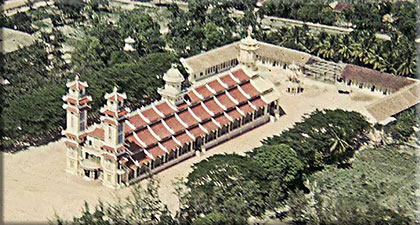 Ahead, as we approached Tay Ninh, we saw a strange church, looking like a hybrid mixture of oriental temple and Spanish mission. “Cao Dai Temple.”
Ahead, as we approached Tay Ninh, we saw a strange church, looking like a hybrid mixture of oriental temple and Spanish mission. “Cao Dai Temple.”
Our flight path took us over the city and onto approach to Tay Ninh West, a huge field with scores of PSP- floored pads for rapid refueling of helicopters. PSP or perforated steel platform became a familiar sight as it provided an easy way to construct an airstrip or cover the mud!
We landed and hovered to our pad. The FARRP gave aircraft a giant gas station where you fueled while still running. To me, it resembled a hive of angry, noisy bees. Rapid refueling of a Cobra required an unusual procedure. Since the Cobra does not carry an onboard crew chief, one of the pilots had to get out and do the job. Strangely, the AC, the senior pilot, had to get out because of the placement of the fuel port on the right side of the aircraft, just behind the AC’s canopy. The AH-1G had a tandem seating arrangement, like most jet fighters. Fueling from the right side required that the AC’s canopy remained closed for the safety of the front seat pilot who remained insidet. I got to stay inside with the cooling system running. Pretty cool.
CPT Lee climbed out, closed his canopy, and retrieved the fuel hose. He began fueling and leaned against the fuselage, while I monitored the gauges.
A series of thumping explosions destroyed our reverie. Mortar rounds impacted in the fueling area. I cranked on the throttle, the signal for the AC to remove hose, close fuel port and remount the aircraft. He moved like his life depended upon it.
While CPT Lee hastily climbed into the rear seat, I brought the engine to full power. Lee called “I’m up.” He took the controls and launched us into the air. I latched my canopy while he bobbed and weaved through the swarm of angry helicopters. I felt good having reacted correctly and not embarrassed myself.

Landing back at the Tay Ninh East airstrip, we rejoined our team. The story of our frantic escape from the FARRP elicited considerable amusement, as they, unburdened by CPT Lee’s tour guide spiel about III Corps, had refueled and departed before the mortar assault.
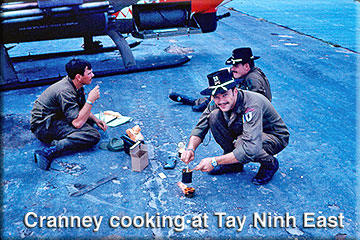 Shutting down, I eyed the unpleasant surroundings. The narrow airstrip had a penta-primed border of dirt and sand covered by sticky tar, which provided no protection from the super-heated atmosphere. Aircrews huddled around or under their aircraft seeking some fragment of shade. Huey crews were envied as they had some space in the troop cabin to relax. Cobra crews flipped open the ammo bay doors and sat there. A few intrepid campers rigged hammocks to the tail stinger. Vietnamese children and women sold sodas and French-style baguettes to hungry crews. Our issued C-Rations provided protein. Canned Turkey Loaf made an excellent sandwich when paired with French bread!
Shutting down, I eyed the unpleasant surroundings. The narrow airstrip had a penta-primed border of dirt and sand covered by sticky tar, which provided no protection from the super-heated atmosphere. Aircrews huddled around or under their aircraft seeking some fragment of shade. Huey crews were envied as they had some space in the troop cabin to relax. Cobra crews flipped open the ammo bay doors and sat there. A few intrepid campers rigged hammocks to the tail stinger. Vietnamese children and women sold sodas and French-style baguettes to hungry crews. Our issued C-Rations provided protein. Canned Turkey Loaf made an excellent sandwich when paired with French bread!
----------------------------------------------------------------------------
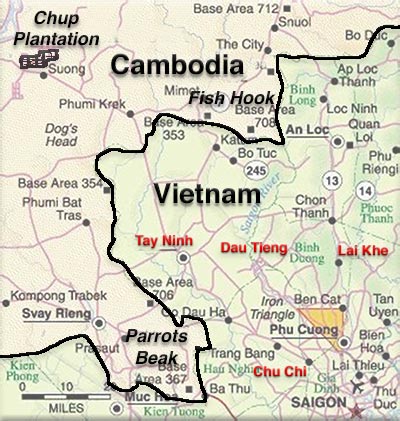
Our team headed north, paralleling highway 22, going “Hot” after clearing the Tay Ninh environs. I saw Thien Ngon, the ARVN base camp to our east. Last chance for fuel or armaments before entering Cambodia. Crossing the border, the terrain and inhabitants felt different. Active war seemed suspended since the ARVN incursion ended some months past. An occasional rice paddy had people riding water buffalo and stooped laborers grooming the crop. Nobody actively pointed guns at us.
My head was constantly on a swivel, glancing at the loach and back down to the map.
Overflying Krek at 4000 feet, the Cambodian city seemed trapped in an earlier century. The highway had become a red dirt track producing clouds of russet gloom as the lonely vehicles transited the ramshackle town. The Chup rubber plantation, largest in Southeast Asia loomed in the distance.
We approached the huge tropical forest, trees aligned like some sullen army waiting to swallow unwary insects. Operations recent briefing had included the cautions that no friendlies were to be expected in our VR area and that 51 cal anti-aircraft activity had been reported. Even experienced ACs had been apprehensive.
“Centaur 49, Centaur 15, call the break” radioed the loach AC, Warrant Officer Boomer. “Roger 15”, CPT Lee replied, “Expect break after we pass Chupville,” troop shorthand for a neat grouping of white-walled French colonial buildings crowned with red tile roofs.
“Remember rules of engagement.” I found the “Rules” to be problematic. We could not fire inside Cambodia unless fired upon. Unless the NVA wanted to be feisty, there would be no action. If they chose to ignore us, they could do so. If not, they threw the first punch!
“15, 49, begin your break.” The loach rolled into a steep diving turn, spiraling down from altitude to tree-top level. Our gunship began a wide orbit, keeping the loach clearly at the center of our vortex. All guns were hot and I grasped the flex sight grips. Any enemy fire would induce a stream of rockets and mini-gunfire from our guarding presence.
Centaur 15 began a continuous report of sightings: enemy bunkers, active trails, occupied encampments, weapons. In that deadly sanctuary, the enemy rested. I itched to fire.
Below, an undisciplined soldier raised his weapon and began targeting our charge. “Taking fire! Taking fire!” burst from the radio. I swung the gunsight, centered the pip behind the fleeing scout and triggered the action of my mini-gun; pouring a torrent of tracers as though sweeping a broom. At 2000 rounds per minute, the mini produced a buzz-saw howl. CPT Lee launched pairs of 17- pounder rockets to suppress the unfriendly fire. The loach zigzagged over the woodland, looking for a clear exit path. Centaur 15 climbed with caution, evading his tormentors.
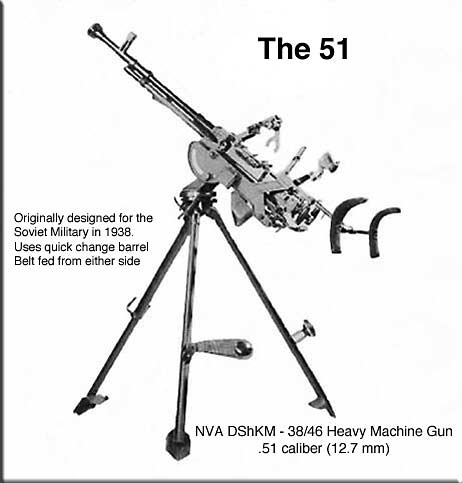 Centaur 33, the UH-1 command and control helicopter called “Covey” our FAC to produce some backup. I continued to fire, allowing my team mates to escape. Green glowing basketballs of howling enemy tracer fire began to zip past our flight. The NVA 51-cal anti-aircraft gunners had laid a trap and we had been sucked into it. One Five zigged and zagged frantically at tree-top level. We followed him with rockets and mini-gun fire.
Centaur 33, the UH-1 command and control helicopter called “Covey” our FAC to produce some backup. I continued to fire, allowing my team mates to escape. Green glowing basketballs of howling enemy tracer fire began to zip past our flight. The NVA 51-cal anti-aircraft gunners had laid a trap and we had been sucked into it. One Five zigged and zagged frantically at tree-top level. We followed him with rockets and mini-gun fire.
"49, 15 going down,” Boomer drawled with suppressed emotion, while disappearing into the greenery below. We began a steep dive toward the ground, searching for some sign of our friends. I felt as though I was perched atop a surfboard, swooping toward an unseen maw full of sharp teeth. In my front seat, the Cobra seemed very ill-protected. The great visibility afforded by the clear canopy now seemed an unfortunate trade-off. I tapped my chicken plate for luck.
“Boomer, pop smoke.” As time passed with no sight of our loach or crew, we pressed our search, passing low over the trees. The C&C continued to coordinate reinforcements for our depleted team; readying his own squad of “Browns,” Vietnamese soldiers trained to quickly attack the enemy and recover downed crews.
With agonizing sloth, wisps of yellow began to appear among a clump of towering trees. “15, 49. We see lemon smoke.” “49, 15, roger lemon,” Boomer affirmed. “Have crew with me, one wounded, three total. Moving to PZ south of smoke. Area appears cold.”
Centaur 33, the Huey, carrying the rescue squad, headed for the clearing. We orbited close overhead and continued to make noisy passes around the recovery area. On touchdown, the squad of “Browns” spread out and headed for the loach crew.
“49, 33 coming out”; the welcome call finally came. We fired the last of our munitions as we escorted the Huey out of the zone. Covey loitered overhead with several flights of fast-movers waiting to destroy the downed aircraft and add their armament to the getaway.
Our small team, now-reunited, headed back to Vietnam, tired but pleased that our injured comrades were headed to safety. I had used all my ammunition and could only wonder at the train of events. A routine VR had turned in the blink of an eye into a life-or-death struggle.
As the adrenaline in my system dissipated, I replayed my first combat mission; eventful, exciting, testing and affirming. I had not screwed up!
I had only 360 more days to go.